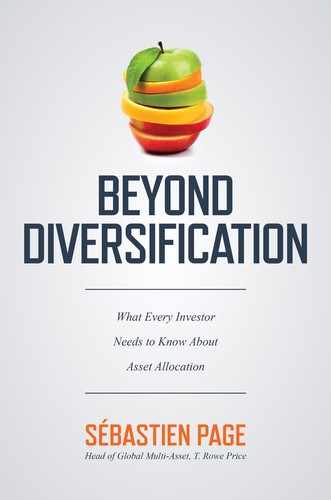PART THREE
PORTFOLIO CONSTRUCTION
Modern Portfolio Theory is simple, because it is developed based on a finite horizon (one period). In a multi-period context, the risk-free rate and the betas can change.
—JPP
Now that we have covered return forecasting across short and long horizons, through equilibrium, valuation, and momentum lenses, as well as risk forecasting from volatility to higher moments, fat tails, and scenarios, a logical progression is to focus on portfolio construction. How do we put it all together?
First, before they optimize the trade-off between forecasted return and risk, multi-asset investors must choose the building blocks. Should we allocate across asset classes, or should we follow a more recent trend and allocate across risk factors? Then we must determine a target risk level, which we can express broadly via the stock and bond mix. This decision requires us to solve a multiperiod optimization problem. Next we must decide whether (and how) to use single-period portfolio optimization to populate the stock and bond mix with the appropriate underlying building blocks.
On the choice of asset classes or risk factors, there are pros and cons to each approach. My view is that both are useful if used in the right context. Most asset allocators still invest across traditional asset classes. Nonetheless, risk factors can be quite useful in improving return and risk forecasts, and in some limited cases, they can be used as stand-alone investments. A tired analogy is that risk factors are the “nutrients” of asset classes. A few essential factors—such as interest rate, equity, currency, and liquidity—cut across all asset classes, just like all foods can be decomposed into fats, carbs, and proteins.
Unfortunately, there’s a lot of hype around risk factors. Major firms (and many startups) have developed commercial applications and products based on factors. Often their goal is to define factors as “asset classes” to raise assets. They do so because the governance process for institutional asset owners is typically quite rigid, such that new types of products face an uphill battle. “Where does it fit within our asset allocation?” is almost always the question. If an investment strategy can have its own “bucket”/asset class, it becomes much easier for its provider to win business. Every time someone presents you with a new asset class, watch your wallet, because that’s where that person’s hand is going.
However, factor analysis and investing are very broad areas of investment management. Many of their applications are quite useful. The important question here is whether factor analysis can improve the portfolio construction process. Rest assured—I’m not trying to sell a factor-based investment strategy.
